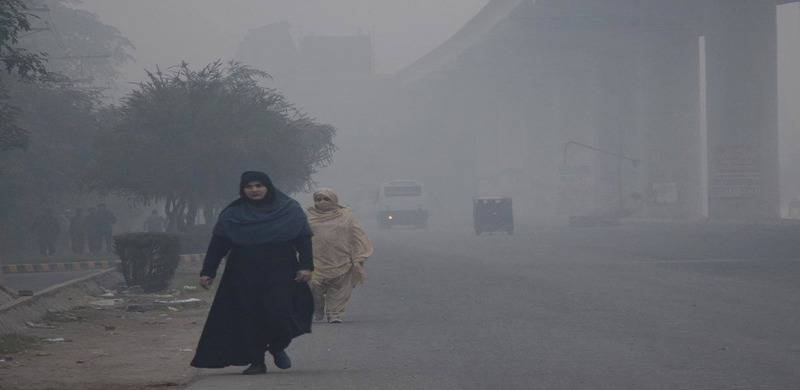
Lahore being in the top among ten most polluted cities of the world has been plagued by smog for four to five years. The increasing urbanization and industrialization has worsened the air quality of the city with air quality index rising to as high as 192 in residential areas and about 298 in industrial areas at present. The smog in Lahore exercises a deep hazardous impact on the health of the citizens with an outbreak of diseases such as asthma, eye, skin and lung infections, and respiratory track allergies.
Research studies have significantly found out that smog not only influences adults and aged individuals but it also has an alarming impact on children. The blood pressure of children is reported to increase due to an exposure to smog. This entails a deteriorating impact on their long-term health. Furthermore, it has been predicted that prevalence of smog for a long time and a greater exposure of children to it is likely to increase possibility of asthma amongst children. Such a situation is synonymous to Great London Smog of 1952 whereby exposure of children to smog during the first year increased their vulnerability to childhood asthma by 20%.
The Environmental Protection Agency of Pakistan has observed and predicted a worsening air quality index in the country. The particulate matter in the air has been reported to be higher than the strict guidelines presented by World Health Organization. In fact, the degree of the particulate matter in the air of Lahore city is fourteen times higher than the guidelines presented by World Health Organization. The air quality of Lahore has been reported to be worse than one of the most polluted megacities of the world, which is Delhi.
The smog prevalent after sunset is usually deep and thick. Exposure to it is tantamount to smoking ten cigarettes at a time. The gradual increase in smog on a daily basis has nullified the comfort from the change in weather. It indeed is extremely irritating and uncomfortable.
It is unfortunate to note that despite the legal approval of the orders to combat smog, lesser efforts of its implementation are framed. Though the print and electronic media is regularly highlighting news of legal orders to control smog such as closure of brick kilns, implementation of zig-zag technology in brick kilns and fining the smoke bellowing vehicles, lesser concrete efforts to implement these have been made.
The environmental regulatory organizations have failed to combat smog properly due to paucity of funds, lack of skilled and trained personnel and shortage of equipment.
In order to curb the alarming effects of smog in Lahore, it is indispensable to disseminate information to the general public about precautionary measures to be adopted during this unpleasant smog season. Public service messages on print and electronic media to tackle the environmental hazard should be broadcasted. Besides, educational brochures and informative pieces should be distributed to create awareness about ways of protecting oneself amidst the weather of smog.
Research studies have significantly found out that smog not only influences adults and aged individuals but it also has an alarming impact on children. The blood pressure of children is reported to increase due to an exposure to smog. This entails a deteriorating impact on their long-term health. Furthermore, it has been predicted that prevalence of smog for a long time and a greater exposure of children to it is likely to increase possibility of asthma amongst children. Such a situation is synonymous to Great London Smog of 1952 whereby exposure of children to smog during the first year increased their vulnerability to childhood asthma by 20%.
The Environmental Protection Agency of Pakistan has observed and predicted a worsening air quality index in the country. The particulate matter in the air has been reported to be higher than the strict guidelines presented by World Health Organization. In fact, the degree of the particulate matter in the air of Lahore city is fourteen times higher than the guidelines presented by World Health Organization. The air quality of Lahore has been reported to be worse than one of the most polluted megacities of the world, which is Delhi.
The smog prevalent after sunset is usually deep and thick. Exposure to it is tantamount to smoking ten cigarettes at a time. The gradual increase in smog on a daily basis has nullified the comfort from the change in weather. It indeed is extremely irritating and uncomfortable.
It is unfortunate to note that despite the legal approval of the orders to combat smog, lesser efforts of its implementation are framed. Though the print and electronic media is regularly highlighting news of legal orders to control smog such as closure of brick kilns, implementation of zig-zag technology in brick kilns and fining the smoke bellowing vehicles, lesser concrete efforts to implement these have been made.
The environmental regulatory organizations have failed to combat smog properly due to paucity of funds, lack of skilled and trained personnel and shortage of equipment.
In order to curb the alarming effects of smog in Lahore, it is indispensable to disseminate information to the general public about precautionary measures to be adopted during this unpleasant smog season. Public service messages on print and electronic media to tackle the environmental hazard should be broadcasted. Besides, educational brochures and informative pieces should be distributed to create awareness about ways of protecting oneself amidst the weather of smog.
